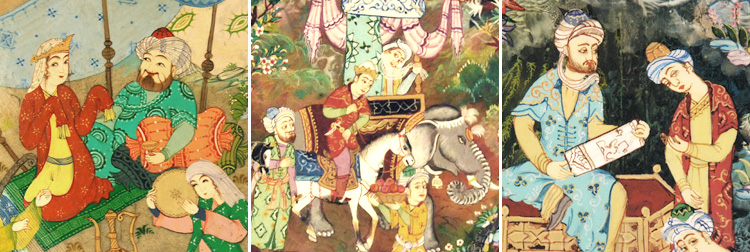Painting arts started making its way into Uzbek artistic styles, and secular themes crept into subject materials. Over time, paintings became more complex with their choice of colors, patterns, and realistic composition. Historical subjects, ways of life, nature and animals (especially birds), and mythological stories became popular subjects. As Islam spread into Uzbekistan, many of the paintings and sculptures that didn’t adhere to the Islamic art rule of not depicting people or animals were destroyed.
After the Russians arrived, they brought with them more European styles of art. And the reason so much of their art is European in style now is because of this influence. Several art schools were set up in Tashkent and Samarkand, and during WWII, many artists left the large Russian art centers for these Uzbek art schools. Uzbek artists got first-hand lessons in European art, and Russian art in particular. As their country gained its independence, they saw a revival of their own cultural arts and history show up in their arts. From painting to woodcarving to murals to sculptures, Uzbek art encompasses the crossroads of the East and the West. Some Uzbek artists to know are Ural Tansykbayev (painter, named People’s Artist of the USSR and Uzbek SSR), Chingiz Akhmarov (painter, muralist), Lekim Ibragimov (graphic artist, painter, professor), and Alisher Mirzo (painter using impressionism and abstract art).
 |
| by Alisher Mirzo |
Uzbek literature also has a long and rich history. The earliest works include a long tradition of oral poetry, legends, and epic tales of heroes fighting against dragons and other evil spirits. One of the most famous of these poems is Alpamysh, which was written in the 10th century. Many of these early poems utilized the folklore of many different groups living in Central Asia at the time.
When Islam was established in Uzbekistan, the face of poetry changed. Common themes turned to morality and other religious instruction-style poetry and prose. Much of this early era was highly influenced by Farsi/Persian and Persian dialects. However, Alisher Navoi did quite a bit of work developing the Uzbek language and Uzbek literature. Zahiriddin Muhammad Babur’s epic poem “Baburname” written during this time is considered one of the greatest works of Uzbek literature.
During the 17th and 18th centuries, the Tajik language had become a common language in Uzbekistan, and many writers wrote in both languages. There was also a division between court poetry and poetry and literature concerning the people. Love poetry became a popular theme during the transition to the 19th century. As the Russians took over, Russian literary styles were taught at literary centers throughout Uzbekistan. Some of the poets and authors of note in the modern times include Abdullah Kadiri (playwright, poet, translator), Abdullah Kahhar (novelist, poet, short story writer, playwright, translator), Hamza Hakimzadeh Niyazi (playwright, poet, author), and Khamid Alimdjan (poet, translator, playwright).
Up next: music and dance




No comments:
Post a Comment